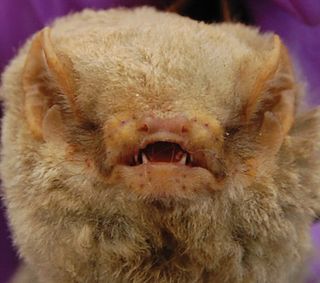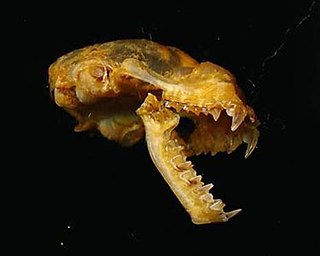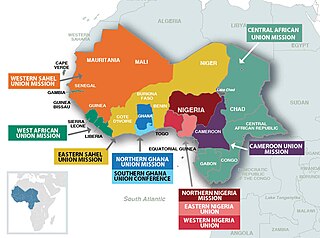
Ricinulei is a small order of arachnids. Like most arachnids, they are predatory, eating small arthropods. They occur today in west-central Africa (Ricinoides) and the Americas as far north as Texas. As of 2021, 91 extant species of ricinuleids have been described worldwide, all in the single family Ricinoididae. In older works they are sometimes referred to as Podogona. Due to their obscurity they do not have a proper common name, though in academic literature they are occasionally referred to as hooded tickspiders.

The individual member states of the African Union (AU) coordinate foreign policy through this agency, in addition to conducting their own international relations on a state-by-state basis. The AU represents the interests of African peoples at large in intergovernmental organizations (IGO's); for instance, it is a permanent observer at the United Nations' General Assembly.

The Guinean forests of West Africa is a biodiversity hotspot designated by Conservation International, which includes the belt of tropical moist broadleaf forests along the coast of West Africa, running from Sierra Leone and Guinea in the west to the Sanaga River of Cameroon in the east. The Dahomey Gap, a region of savanna and dry forest in Togo and Benin, divides the Guinean forests into the Upper Guinean forests and Lower Guinean forests.

The Upper Guinean forests is a tropical seasonal forest region of West Africa. The Upper Guinean forests extend from Guinea and Sierra Leone in the west through Liberia, Côte d'Ivoire and Ghana to Togo in the east, and a few hundred kilometers inland from the Atlantic coast. A few enclaves of montane forest lie further inland in the mountains of central Guinea and central Togo and Benin.

The Guinean forest–savanna mosaic is an ecoregion of West Africa, a band of interlaced forest, savanna, and grassland running east to west and dividing the tropical moist forests near the coast from the West Sudanian savanna of the interior.

The Abo bat is a species of vesper bat in the family Vespertilionidae. It is found in several countries in West Africa and Central Africa. It is found in subtropical and tropical dry and moist lowland forests.

The dark-winged lesser house bat is a species of vesper bat. It can be found in Angola, Benin, Cameroon, Central African Republic, Chad, Democratic Republic of the Congo, Republic of Côte d'Ivoire, Ethiopia, Gambia, Ghana, Guinea, Kenya, Malawi, Mozambique, Nigeria, Senegal, Sierra Leone, Somalia, Sudan, Tanzania, Uganda, and Zambia.

The Benito roundleaf bat is a species of bat in the family Hipposideridae found in Cameroon, Central African Republic, Republic of the Congo, Democratic Republic of the Congo, Ivory Coast, Equatorial Guinea, Gabon, Ghana, Guinea, Liberia, Nigeria, Sierra Leone, South Sudan, and Togo. Its natural habitat is subtropical or tropical moist lowland forests.
Belonophora is a genus of flowering plants in the family Rubiaceae. It is found in Tropical Africa from Senegal east to Sudan and south to Angola. It was described by Joseph Dalton Hooker in 1873.
Utricularia reflexa is a small to medium-sized suspended aquatic carnivorous plant that belongs to the genus Utricularia. U. reflexa is native to Africa and can be found in Benin, Burkina Faso, Burundi, Cameroon, Chad, the Central African Republic, Côte d'Ivoire, the Democratic Republic of the Congo, Gambia, Ghana, Guinea, Kenya, Madagascar, Malawi, Mali, Niger, Nigeria, Senegal, Sierra Leone, Sudan, Tanzania, Togo, Uganda, Zambia, and Zimbabwe.
Utricularia firmula is a small annual carnivorous plant that belongs to the genus Utricularia. It is native to tropical and southern Africa, where it can be found in Angola, Cameroon, Côte d'Ivoire, the Democratic Republic of the Congo, Ghana, Guinea, Guinea-Bissau, Kenya, Liberia, Madagascar, Malawi, Mali, Mozambique, Nigeria, Senegal, Sierra Leone, South Africa, Sudan, Tanzania, The Gambia, Togo, Uganda, Zambia, and Zimbabwe. U. firmula grows as a terrestrial plant in damp, sandy or peaty soils in grasslands or on wet, mossy rocks, often as a weed in rice fields at altitudes from near sea level to 2,100 m (6,890 ft). It typically flowers toward the end of the wet season. It was originally named by Friedrich Welwitsch but formally described and published by Daniel Oliver in 1865.

The West-Central Africa Division (WAD) of Seventh-day Adventists is a sub-entity of the General Conference of Seventh-day Adventists, which coordinates the Church's operations in 22 African countries, which include Benin, Burkina Faso, Cameroon, Cape Verde, Central African Republic, Chad, Congo, Equatorial Guinea, Gabon, Gambia, Ghana, Guinea, Guinea-Bissau, Ivory Coast, Liberia, Mali, Mauritania, Niger, Nigeria, Senegal, Sierra Leone, and Togo. Its headquarters is in Abidjan, Côte d'Ivoire. Founded in 2003, the division membership as of June 30, 2021 is 889,196
Craterispermum is a genus of flowering plants in the family Rubiaceae. It contains 16 species that occur in tropical Africa and Seychelles. It is the only genus in the tribe Craterispermeae, of which the divergence time is estimated at 34.8 million years ago.
Cyanothemis is a monotypic genus of dragonflies in the family Libellulidae containing the single species Cyanothemis simpsoni. It is known by the common name bluebolt. It is native to central Africa, where it is known from Cameroon, the Democratic Republic of the Congo, Côte d'Ivoire, Ghana, Guinea, Liberia, Nigeria and Sierra Leone.

Cryptocellus is an arachnid genus in the order Ricinulei, first described by John Westwood in 1874. It is native to the Neotropics.
Gambeya is a genus of flowering plants belonging to the family Sapotaceae.










